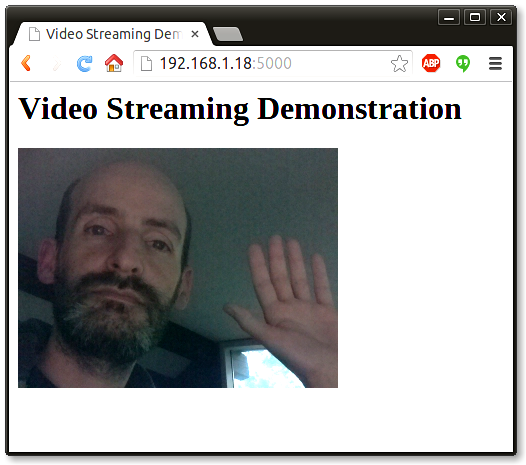Video Streaming with Flask
Posted by
on underI'm sure by now you know that I have released a book and a couple of videos on Flask in cooperation with O'Reilly Media. While the coverage of the Flask framework in these is fairly complete, there are a small number of features that for one reason or another did not get mentioned much, so I thought it would be a good idea to write articles about them here.
This article is dedicated to streaming, an interesting feature that gives Flask applications the ability to provide large responses efficiently partitioned in small chunks, potentially over a long period of time. To illustrate the topic I'm going to show you how to build a live video streaming server!
NOTE: there is now a follow-up to this article, Flask Video Streaming Revisited, in which I describe some improvements to the streaming server introduced here.
What is Streaming?
Streaming is a technique in which the server provides the response to a request in chunks. I can think of a couple of reasons why this might be useful:
- Very large responses. Having to assemble a response in memory only to return it to the client can be inefficient for very large responses. An alternative would be to write the response to disk and then return the file with
flask.send_file(), but that adds I/O to the mix. Providing the response in small portions is a much better solution, assuming the data can be generated in chunks. - Real time data. For some applications a request may need to return data that comes from a real time source. A pretty good example of this is a real time video or audio feed. A lot of security cameras use this technique to stream video to web browsers.
Implementing Streaming With Flask
Flask provides native support for streaming responses through the use of generator functions. A generator is a special function that can be interrupted and resumed. Consider the following function:
def gen():
yield 1
yield 2
yield 3
This is a function that runs in three steps, each returning a value. Describing how generator functions are implemented is outside the scope of this article, but if you are a bit curious the following shell session will give you an idea of how generators are used:
>>> x = gen()
>>> x
<generator object gen at 0x7f06f3059c30>
>>> next(x)
1
>>> next(x)
2
>>> next(x)
3
>>> next(x)
Traceback (most recent call last):
File "<stdin>", line 1, in <module>
StopIteration
You can see in this simple example that a generator function can return multiple results in sequence. Flask uses this characteristic of generator functions to implement streaming.
The example below shows how using streaming it is possible to generate a large data table, without having to assemble the entire table in memory:
from flask import Response, render_template
from app.models import Stock
def generate_stock_table():
yield render_template('stock_header.html')
for stock in Stock.query.all():
yield render_template('stock_row.html', stock=stock)
yield render_template('stock_footer.html')
@app.route('/stock-table')
def stock_table():
return Response(generate_stock_table())
In this example you can see how Flask works with generator functions. A route that returns a streamed response needs to return a Response object that is initialized with the generator function. Flask then takes care of invoking the generator and sending all the partial results as chunks to the client.
For this particular example if you assume Stock.query.all() returns the result of a database query as an iterable, then you can generate a potentially large table one row at a time, so regardless of the number of elements in the query the memory consumption in the Python process will not grow larger and larger due to having to assemble a large response string.
Multipart Responses
The table example above generates a traditional page in small portions, with all the parts concatenated into the final document. This is a good example of how to generate large responses, but something a little bit more exciting is to work with real time data.
An interesting use of streaming is to have each chunk replace the previous one in the page, as this enables streams to "play" or animate in the browser window. With this technique you can have each chunk in the stream be an image, and that gives you a cool video feed that runs in the browser!
The secret to implement in-place updates is to use a multipart response. Multipart responses consist of a header that includes one of the multipart content types, followed by the parts, separated by a boundary marker and each having its own part specific content type.
There are several multipart content types for different needs. For the purpose of having a stream where each part replaces the previous part the multipart/x-mixed-replace content type must be used. To help you get an idea of how this looks, here is the structure of a multipart video stream:
HTTP/1.1 200 OK
Content-Type: multipart/x-mixed-replace; boundary=frame
--frame
Content-Type: image/jpeg
<jpeg data here>
--frame
Content-Type: image/jpeg
<jpeg data here>
...
As you see above, the structure is pretty simple. The main Content-Type header is set to multipart/x-mixed-replace and a boundary string is defined. Then each part is included, prefixed by two dashes and the part boundary string in their own line. The parts have their own Content-Type header, and each part can optionally include a Content-Length header with the length in bytes of the part payload, but at least for images browsers are able to deal with the stream without the length.
Building a Live Video Streaming Server
There's been enough theory in this article, now it is time to build a complete application that streams live video to web browsers.
There are many ways to stream video to browsers, and each method has its benefits and disadvantages. The method that works well with the streaming feature of Flask is to stream a sequence of independent JPEG pictures. This is called Motion JPEG, and is used by many IP security cameras. This method has low latency, but quality is not the best, since JPEG compression is not very efficient for motion video.
Below you can see a surprisingly simple, yet complete web application that can serve a Motion JPEG stream:
#!/usr/bin/env python
from flask import Flask, render_template, Response
from camera import Camera
app = Flask(__name__)
@app.route('/')
def index():
return render_template('index.html')
def gen(camera):
while True:
frame = camera.get_frame()
yield (b'--frame\r\n'
b'Content-Type: image/jpeg\r\n\r\n' + frame + b'\r\n')
@app.route('/video_feed')
def video_feed():
return Response(gen(Camera()),
mimetype='multipart/x-mixed-replace; boundary=frame')
if __name__ == '__main__':
app.run(host='0.0.0.0', debug=True)
This application imports a Camera class that is in charge of providing the sequence of frames. Putting the camera control portion in a separate module is a good idea in this case, this way the web application remains clean, simple and generic.
The application has two routes. The / route serves the main page, which is defined in the index.html template. Below you can see the contents of this template file:
<html>
<head>
<title>Video Streaming Demonstration</title>
</head>
<body>
<h1>Video Streaming Demonstration</h1>
<img src="{{ url_for('video_feed') }}">
</body>
</html>
This is a simple HTML page with just a heading and an image tag. Note that the image tag's src attribute points to the second route of this application, and this is where the magic happens.
The /video_feed route returns the streaming response. Because this stream returns the images that are to be displayed in the web page, the URL to this route is in the src attribute of the image tag. The browser will automatically keep the image element updated by displaying the stream of JPEG images in it, since multipart responses are supported in most/all browsers (let me know if you find a browser that doesn't like this).
The generator function used in the /video_feed route is called gen(), and takes as an argument an instance of the Camera class. The mimetype argument is set as shown above, with the multipart/x-mixed-replace content type and a boundary set to the string "frame".
The gen() function enters a loop where it continuously returns frames from the camera as response chunks. The function asks the camera to provide a frame by calling the camera.get_frame() method, and then it yields with this frame formatted as a response chunk with a content type of image/jpeg, as shown above.
Obtaining Frames from a Video Camera
Now all that is left is to implement the Camera class, which will have to connect to the camera hardware and download live video frames from it. The nice thing about encapsulating the hardware dependent part of this application in a class is that this class can have different implementations for different people, but the rest of the application remains the same. You can think of this class as a device driver, which provides a uniform implementation regardless of the actual hardware device in use.
The other advantage of having the Camera class separated from the rest of the application is that it is easy to fool the application into thinking there is a camera when in reality there is not, since the camera class can be implemented to emulate a camera without real hardware. In fact, while I was working on this application, the easiest way for me to test the streaming was to do that and not have to worry about the hardware until I had everything else running. Below you can see the simple emulated camera implementation that I used:
from time import time
class Camera(object):
def __init__(self):
self.frames = [open(f + '.jpg', 'rb').read() for f in ['1', '2', '3']]
def get_frame(self):
return self.frames[int(time()) % 3]
This implementation reads three images from disk called 1.jpg, 2.jpg and 3.jpg and then returns them one after another repeatedly, at a rate of one frame per second. The get_frame() method uses the current time in seconds to determine which of the three frames to return at any given moment. Pretty simple, right?
To run this emulated camera I needed to create the three frames. Using gimp I've made the following images:



Because the camera is emulated, this application runs on any environment, so you can run this right now! I have this application all ready to go on GitHub. If you are familiar with git you can clone it with the following command:
$ git clone https://github.com/miguelgrinberg/flask-video-streaming.git
If you prefer to download it, then you can get a zip file here.
Once you have the application installed, create a virtual environment and install Flask in it. Then you can run the application as follows:
$ python app.py
After you start the application enter http://localhost:5000 in your web browser and you will see the emulated video stream playing the 1, 2 and 3 images over and over. Pretty cool, right?
Once I had everything working I fired up my Raspberry Pi with its camera module and implemented a new Camera class that converts the Pi into a video streaming server, using the picamera package to control the hardware. I will not discuss this camera implementation here, but you can find it in the source code in file camera_pi.py.
If you have a Raspberry Pi and a camera module you can edit app.py to import the Camera class from this module and then you will be able to live stream the Pi camera, like I'm doing in the following screenshot:

If you want to make this streaming application work with a different camera, then all you need to do is write another implementation of the Camera class. If you end up writing one I would appreciate it if you contribute it to my GitHub project.
Limitations of Streaming
When the Flask application serves regular requests the request cycle is short. The web worker receives the request, invokes the handler function and finally returns the response. Once the response is sent back to the client the worker is free and ready to take on another request.
When a request that uses streaming is received, the worker remains attached to the client for the duration of the stream. When working with long, never ending streams such as a video stream from a camera, a worker will stay locked to the client until the client disconnects. This effectively means that unless specific measures are taken, the application can only serve as many clients as there are web workers. When working with the Flask application in debug mode that means just one, so you will not be able to connect a second browser window to watch the stream from two places at the same time.
There are ways to overcome this important limitation. The best solution in my opinion is to use a coroutine based web server such as gevent, which Flask fully supports. With the use of coroutines gevent is able to handle multiple clients on a single worker thread, as gevent modifies the Python I/O functions to issue context switches as necessary.
Conclusion
In case you missed it above, the code that supports this article is this GitHub repository: https://github.com/miguelgrinberg/flask-video-streaming/tree/v1. Here you can find a generic implementation of video streaming that does not require a camera, and also an implementation for the Raspberry Pi camera module. This follow-up article describes some improvements I made after this article was published originally.
I hope this article shed some light on the topic of streaming. I concentrated on video streaming because that is an area I have some experience, but streaming has many more uses besides video. For example, this technique can be used to keep a connection between the client and the server alive for a long time, allowing the server to push new information the moment it becomes available. These days the Web Socket protocol is a more efficient way to achieve this, but Web Socket is fairly new and works only in modern browsers, while streaming will work on pretty much any browser you can think of.
If you have any questions feel free to write them below. I plan to continue documenting more of the not well known Flask topics, so I hope you connect with me in some way to know when more articles are published. I hope to see you in the next one!
Miguel
-
#426 Miguel Grinberg said
@Prafull: use the IP address of the computer running the server when connecting.
-
#427 pravalika said
how to develop a flask API which ask the user to upload a video and make the user to watch it.
can you help me just with simple idea? -
#428 Miguel Grinberg said
@pravalika: Being able to describe what you want in one short sentence does not make it simple. What you are asking for would take some effort, impossible for me to describe it in a comment.
-
#429 Ranajoy said
Hey Miguel,
Hope you are doing good and appreciate the content, it's really helpful.
I have a query regarding the case of failure in between the stream. If in case, stream breaks or some exception occurs, is there any way of sending 500 http response?
I tried but as it's yielding frames, it's first sending 200 as header and I'm unable to send any other header on failure.Thanks !!
-
#430 Miguel Grinberg said
@Ranajoy: You can't change the status code once sent. The 200 code was sent out when the stream started, the only thing you can do if an error occurs is to stop streaming.
-
#431 Adithya Narayan said
Hey, I want to know , how i can send a series of frames from the live web capture of a browser to my python API for analysis. The thing is that using Open CV invokes the actual camera of the system, for a server deployed on the cloud this isn't possible and i would have to rely on the browser camera capture right? How do i accomplish this?
-
#432 Miguel Grinberg said
@Adithya: this project streams video from server to clients, so it is not really made to handle your use case, which is the reverse of that.
-
#433 Tate Peñaranda said
This is great Miguel, thanks!
-
#434 epsi95 said
I really want to thank you for the article. One thing I want to know is, is it okay to use threading in Flask with any server (test like Flask test or production server like Gunicorn, Uwsgi etc)? Can those servers kill my threads anytime? If using threading is not advised what should be done in Flask apps to do some work in the background.
-
#435 Miguel Grinberg said
@epsi95: threads are fine to use. Are you concerned about the threads being killed? In Python threads cannot be killed, they have to exit voluntarily.
-
#436 epsi95 said
Thanks for the answer, actually this concern comes from a StackOverflow comment where someone says
"""
Don't run threads in WSGI applications like Flask. While the development server does only very basic threading stuff, any real WSGI server suitable for production will manage its threads and might spawn several and kill them after some time. This can even happen for whole processes.
"""
Is this argument legitimate? Or I can use the thread safely? -
#437 Miguel Grinberg said
@epsi95: I don't think I have enough context to tell you what I think about this quote, but I don't see how it applies to this case, and the part about threads getting killed is incorrect.
-
#438 Favour said
How can I yield a video and string simultaneously
-
#439 Miguel Grinberg said
@Favour: With the Motion-JPEG algorithm shown in this article you can't. There is no provision for returning metadata along with video frames.
-
#440 yulong said
any way to yield (b'--frame\r\n' b'Content-Type: image/jpeg\r\n\r\n' + frame + b'\r\n') together with some variable (thats some) to index.html?
-
#441 Miguel Grinberg said
@yulong: you can yield any data that you want, but if you want a video stream to play in the browser you have to follow the rules of the motion-jpeg format. If you change the format then you will have to interpret the stream yourself in the browser.
-
#442 muhammad tariq said
i can't stream more than 6 videos at a time
My issue is just like this
https://stackoverflow.com/questions/71098979/how-to-stream-and-save-web-camera-video-via-a-server -
#443 Miguel Grinberg said
@muhammad: This is likely a limitation web browsers have, not something that is controlled by the server.
-
#444 Mike said
Hi Miguel, your examples are extremely helpful as are your books (of which I have 2). This video stream example works perfectly. I've replaced the host='0.0.0.0' with a static IP address because I've noticed in Chrome that this resolves to localhost and won't get the video/image stream. However, I'm struggling with a different problem: I wish to show a counter/timer alongside my webcamera image and cannot figure out how to make both the frame captured data (video) and the numerical timer appear simultaneously on the same webpage. Any thoughts? Thanks in advance!
-
#445 Miguel Grinberg said
@Mike: Unfortunately this method of streaming does not allow for synchronizing anything else to the stream. Sorry.
-
#446 Beatrice said
Dear Miguel,
is there a way to make the (updated) session accessible within the gen() function?
Assume that you want to change the intensity of the frames yielded by the gen() according to a user input.
How can you do?Thank you.
-
#447 Miguel Grinberg said
@Beatrice: A cookie based session is not going to work, because the generator endpoint will never see updates made through other endpoints. But if you store your settings in back end storage such as Redis then the gen() function can retrieve the vlaues before each frame and use them to do processing.
-
#448 Kurt said
Hey Miguel and thanks for your great posts!
my question is about streaming, not video, but file download. For stream downloading multiple files (ant file types) from a server I've used zipstream-ng. The great thing about that library is that the downloaded zip file preserves the folder structure on the server, so the files inside the zip file is arranged in folders (starting from the top folder you specify). Further, it does not buffer on the server (and hence avoids the risk of filling up the server with temporary zip files). However, I have not been able to find a way to obtain the same thing for downloading from an AWS S3 storage via Flask. I have found ways for streaming single files, as well as creating a zip file on the flask server before downloading to the user, but I cannot use any of those because my users need to be able to download tousands of files, and they need to be organized in folders as on the server, else it will be impossible for the user to navigate efficiently when using the files on his computer. Do you have any idea how I could do this? -
#449 Miguel Grinberg said
@Kurt: I don't know of any alternative, but I suppose you can take the code from the package you use and adapt it to get files from S3. Probably easier said than done, but if you have no other option, maybe that could work.
-
#450 ali lotfi said
hi! I have code similar to this when I run it on the server it has no access to the webcam
Of course, I also tested the same code on the Ubuntu server and the webcam has no output on the screen and the screen is blank and white.



